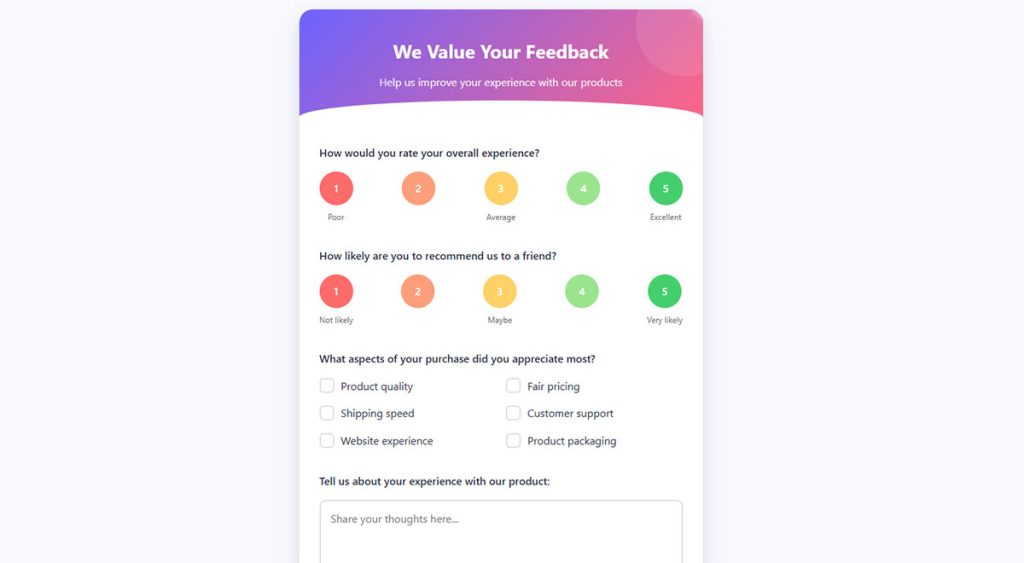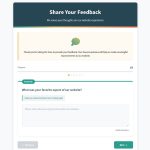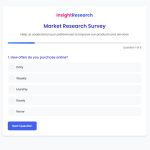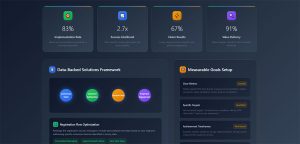You send a survey. Half your audience ignores it. The other half quits halfway through. Sound familiar? Survey fatigue is killing your response rates and destroying data quality. When participants…
Table of Contents
Every completed purchase tells only half the story. What happens after customers click “buy” determines whether they’ll return or leave forever. Post-purchase survey questions transform silent transactions into valuable conversations.
Customer feedback forms do more than collect opinions. They reveal the truth behind your metrics. When 91% of unhappy customers simply disappear without complaining, your purchase experience evaluation becomes critical for business survival.
This comprehensive guide will help you:
- Design effective buyer satisfaction questionnaires that people actually complete
- Craft questions that generate actionable consumer insight collection
- Implement distribution strategies that maximize response rates
- Transform feedback into measurable business improvements
Whether you’re using IvyForms, or building custom solutions, these strategies will help you measure customer experience effectively. By the end, you’ll have everything needed to create post-sale evaluations that strengthen customer relationships while driving genuine business growth.
Designing Effective Survey Questions
Question design makes or breaks your post-purchase feedback. Poor questions lead to useless data. Great ones unlock customer insights that transform businesses.
Question Types and Formats
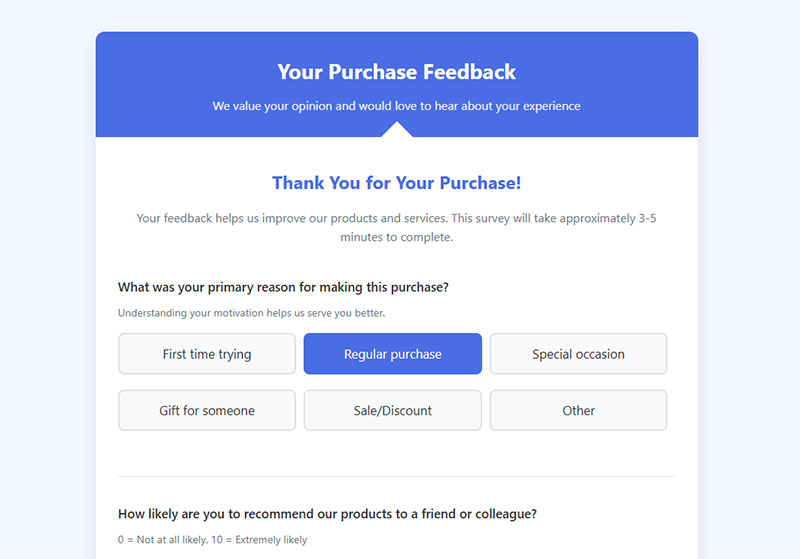
The backbone of any customer feedback form includes several formats:
Multiple choice vs. open-ended questions serve different purposes. Multiple choice options:
- Quick to complete
- Easy to analyze
- Provide quantifiable data
Open-ended questions capture nuanced feedback impossible to predict. They reveal pain points and customer language while gathering product improvement suggestions.
Rating scales provide structured measurement. The Net Promoter Score (NPS) asks “How likely are you to recommend?” on a 0-10 scale. Customer Satisfaction Score (CSAT) measures specific experiences. Likert scales evaluate agreement levels from “strongly disagree” to “strongly agree.”
Binary questions create simple yes/no splits. “Did you find what you were looking for?” Perfect for checkout friction points or mobile shopping experience evaluation.
Picture-based questions boost engagement. Visual feedback tools like JotForm allow customers to mark specific areas of product images or screenshots. These work brilliantly for packaging assessment.
Question Structure Best Practices

Clear language matters. Ask “How satisfied were you with delivery speed?” not “Was our logistical fulfillment timeline adequate?” User experience questions must avoid jargon.
Avoid leading questions that bias results. “How amazing was our support team?” pushes respondents toward positive answers. Instead ask “How would you rate our support team?”
Specific language outperforms generalities. “Did you find our checkout process easy to use?” beats “Was your experience good?” Specificity provides actionable consumer insight collection.
Balance positive and negative framing. Include “What did you dislike?” alongside “What did you like?” This approach improves your voice of customer data quality.
Timing and Length Considerations
Survey length dramatically impacts completion. The ideal post-sale evaluation contains 5-7 questions. Longer surveys see sharp drop-offs in response rates.
Timing matters equally. Send your purchase experience evaluation:
- Immediately for service feedback
- After delivery for product feedback
- 7-14 days after use for durability feedback
Response rates decline with survey length. Customer effort score measurement shows that each additional question reduces completion by approximately 5-8%.
Improve participation through:
- Mobile-friendly design
- Progress indicators
- Estimated completion time
- Skip logic for irrelevant questions
Essential Question Categories
Every comprehensive survey question set needs to cover key areas.
Product Satisfaction Questions
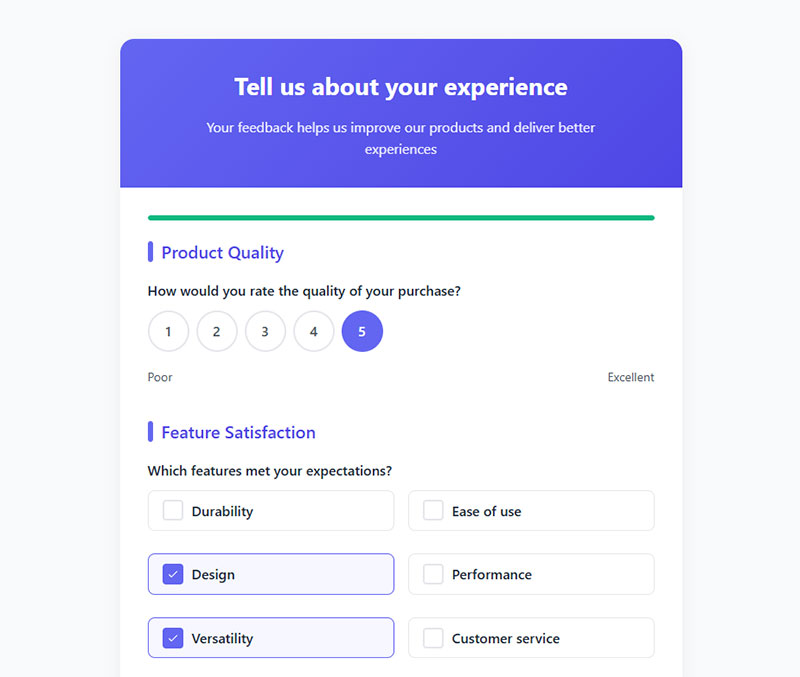
Start with product quality assessment. “How would you rate the quality of your purchase?” establishes a baseline.
Feature satisfaction rating reveals specific strengths and weaknesses. “Which features met your expectations?” followed by “Which features disappointed you?” provides balanced feedback.
Value perception matters enormously. “Do you feel the product was worth the price?” directly measures price satisfaction query results.
Compare your offering against alternatives. “How does our product compare to similar ones you’ve used?” generates competitive comparison insights that marketing teams crave.
Purchase Experience Questions
Website usability feedback questions assess navigation. “How easy was finding the right product?” identifies site friction.
The checkout process assessment remains critical. “Did you encounter any obstacles while checking out?” finds conversion barriers.
Payment options satisfaction affects completion rates. “Were you able to pay using your preferred method?”
For e-commerce platforms, investigate device differences. “Did you complete your purchase on mobile or desktop?” followed by satisfaction questions uncovers cross-platform issues.
Customer Service Evaluation
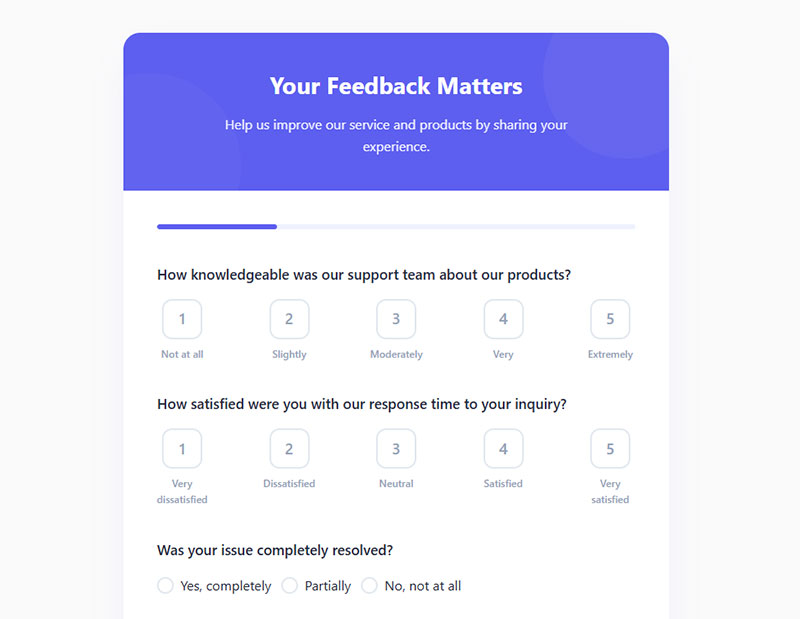
Staff knowledge measurement reveals training gaps. “How knowledgeable was our support team about our products?”
Response time satisfaction directly impacts CSAT measurement. “How satisfied were you with our response time to your inquiry?”
Problem resolution effectiveness questions like “Was your issue completely resolved?” identify service quality indicators.
Compare pre and post-purchase support. “How would you rate support before your purchase compared to after?” highlights inconsistencies in customer support evaluation.
Delivery and Fulfillment Questions
Shipping speed satisfaction determines repeat purchases. “How satisfied were you with the delivery time?”
Packaging quality matters increasingly. “Did the packaging adequately protect your product?” and “What did you think of our packaging design?” measure both function and impression.
Product condition upon arrival affects return rates. “Did your product arrive in perfect condition?” helps assess shipping damage frequency.
Returns process feedback reveals friction points. “How easy was initiating a return?” and “How quickly did you receive your refund?” measure a critical aspect of the consumer opinion gathering process.
Thoughtful survey design transforms basic questioning into strategic customer relationship management. Use these guidelines to create surveys that generate actionable insights while respecting your customers’ time.
Advanced Question Techniques
Beyond basic questions lie sophisticated techniques that extract deeper customer insights. Smart survey design transforms ordinary feedback into strategic intelligence.
Segmentation-Based Questions
Demographic collection provides context for other responses. Simple questions like “What is your age range?” or “How frequently do you shop online?” help categorize feedback for more meaningful analysis.
IvyForms excels at creating segmented surveys that adapt based on previous answers. This allows for purchase motivation inquiry without overwhelming respondents.
Customer persona identification questions reveal who’s buying and why:
- “What best describes your role?”
- “How do you primarily use our product?”
- “Which features matter most to you?”
Shopping habit indicators help predict future behavior. “How often do you purchase products in this category?” provides purchase reflection context essential for inventory planning.
Competitive Intelligence Questions
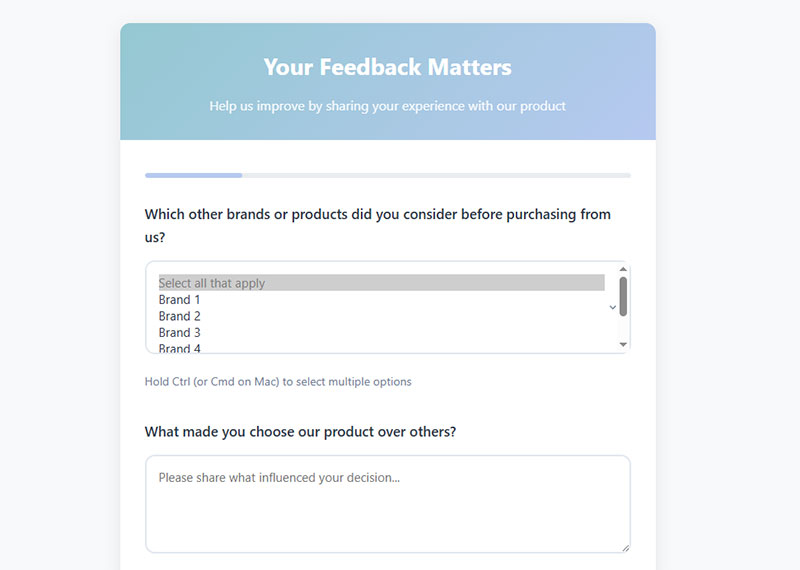
Brand comparison questions deliver critical market positioning data. “Which other brands did you consider?” followed by “Why did you choose us instead?” reveals competitive advantage identification opportunities.
Ask about alternative options considered:
- “Which other products did you evaluate?”
- “What made you choose our product over others?”
- “What features do competitors offer that we don’t?”
Switching behavior indicators help retention efforts. “Have you previously purchased from another brand in this category?” followed by “What prompted your switch?” reveals acquisition triggers.
These competitive comparison questions must be carefully worded. Avoid leading questions that mention specific competitors, as this biases responses and skews sentiment analysis results.
Emotional Connection Questions
Brand perception queries tap into feelings. “What three words would you use to describe our brand?” provides qualitative emotional response data.
Customer Relationship Management systems can track emotional responses over time. This reveals shifting perceptions that quantitative metrics might miss.
Brand values alignment questions matter increasingly. “How important is our environmental commitment to your purchase decision?” measures how corporate values impact buying behavior.
Social proof questions explore community influence. “Did recommendations from others influence your purchase?” followed by “Where did you hear about us?” maps word-of-mouth patterns.
Implementing Survey Insights
Collecting data means nothing without analysis and action. Effective post-purchase survey programs close the feedback loop.
Data Analysis Methods
Quantitative vs. qualitative analysis requires different approaches. Numeric ratings (NPS, CSAT, Customer Effort Score) provide trackable metrics. Open responses need careful coding and categorization.
User testing platforms like Qualtrics offer sophisticated trend identification techniques. Pattern recognition in responses highlights emerging issues before they become widespread.
Priority scoring methods help focus efforts. Weight feedback based on:
- Frequency (how often mentioned)
- Intensity (emotional strength)
- Impact on retention
- Implementation difficulty
Cross-reference survey data with sales metrics. Do customers who report higher satisfaction actually purchase more? Data analytics reveals these connections.
Turning Feedback into Action Plans
Creating actionable improvement plans requires structure. For each major issue identified:
- Document specific problems
- Brainstorm potential solutions
- Evaluate implementation requirements
- Set measurable success metrics
Set clear goals based on feedback. “Improve shipping speed satisfaction by 15% within 90 days” provides better direction than “fix shipping problems.”
Assign specific responsibility for each improvement area. Customer experience management requires clear ownership of action items with defined timelines.
Develop realistic implementation schedules. Quick wins build momentum, while structural changes may require longer timelines with interim measurement.
Closing the Feedback Loop
Communicate changes to respondents. Nothing builds loyalty faster than telling customers “You spoke, we listened.” Email updates on improvements directly address pain points raised in their purchase journey feedback.
Follow up with survey participants through:
- Direct email acknowledgment
- “You helped us improve” campaigns
- Before/after comparisons
Measure the impact of implemented changes through repeat surveys. Track satisfaction scores on specific dimensions before and after improvements to confirm effectiveness.
Build continuous improvement cycles using Voice of Customer programs. Regular post-purchase survey questions establish baseline metrics that track progress over time.
Converting user experience feedback into tangible improvements delivers measurable ROI. Each enhancement in product quality, service delivery, or website usability drives customer lifetime value growth and strengthens consumer opinion gathering systems.
Survey Distribution Strategies
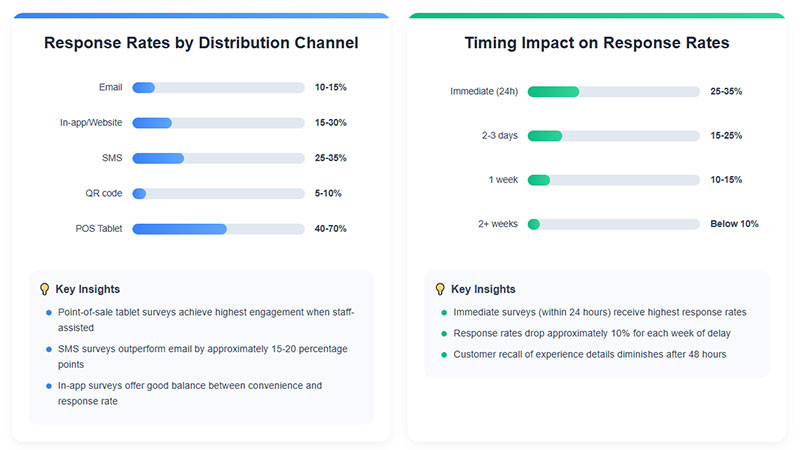
Distribution can make or break your post-purchase feedback collection efforts. Strategic delivery dramatically impacts response rates.
Channel Selection
Email survey best practices start with compelling subject lines. “Your feedback shapes our future” outperforms “Please complete our survey.” Personalization in the email boosts open rates by 26% according to customer insight collection metrics.
Time your purchase experience evaluation emails strategically:
- 1-3 days after delivery for product feedback
- Immediately after support interactions
- Mid-morning on weekdays for highest open rates
Website survey integration captures feedback while experience remains fresh. Embedded survey tools like Qualtrics trigger based on:
- Purchase completion
- Return visits
- Cart abandonment
- Time on page
SMS survey considerations require extreme brevity. Limit mobile surveys to 2-3 critical customer experience measurement questions with clear opt-out instructions. Response rates for order fulfillment questions via SMS often exceed email by 3-4x.
Social media surveys work well for audience segments comfortable with these platforms. Instagram polls and Facebook surveys generate high visibility but potentially biased sampling.
Incentive Strategies
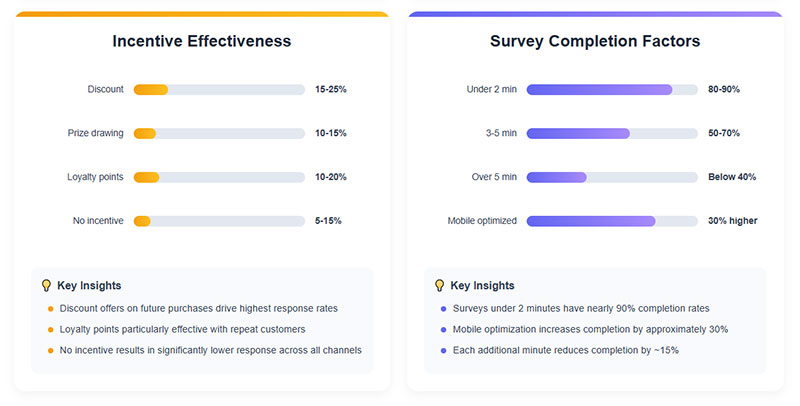
Discount codes drive completion. “Share your thoughts and get 15% off your next purchase” creates dual benefits—feedback and repeat sales. Aligning incentives with customer loyalty programs multiplies effectiveness.
Loyalty points or rewards leverage existing programs. “Earn 500 points for completing our product satisfaction inquiry” works especially well for frequent buyers.
Charitable donations appeal to values-driven customers. “We’ll donate $5 to charity for each completed survey” aligns with brand perception questions and social identity positioning.
Contest entries generate excitement. “Complete our feedback for a chance to win” drives higher participation from price-sensitive segments. SurveyMonkey data suggests prize draw incentives improve consumer opinion gathering rates by 15-30%.
Targeting and Personalization
Customer segmentation enables targeted questioning. New customers receive different checkout process assessment questions than repeat buyers. This approach respects the buyer’s experience level with your brand.
Purchase-specific question customization shows respect for customer time. Asking about specific products purchased rather than your entire catalog demonstrates attention to the individual shopping experience evaluation.
Personalized introductions dramatically impact completion rates. “John, your recent purchase of X matters to us” feels more engaging than generic appeals for feedback.
Response-adaptive question paths prevent irrelevant questions. If a customer rates delivery poorly, smart surveys automatically probe for specific shipping speed satisfaction issues.
Measuring Survey Effectiveness
Robust measurement systems ensure your post-purchase survey questions deliver value.
Response Rate Metrics
Calculating response rates requires clear definitions. Track:
- View-to-start ratio
- Start-to-completion percentage
- Average completion time
- Abandonment points
Industry benchmarks vary widely. E-commerce post-sale evaluation typically achieves 5-15% completion rates, while high-end purchase experience surveys may reach 25-30% with proper incentives.
Survey fatigue indicators signal problems. Watch for:
- Declining response rates over time
- Increased abandonment at specific questions
- Shorter answers to open-ended questions
- Less thoughtful feedback
Methods to improve participation include:
- Progressive disclosure (revealing questions gradually)
- Mobile optimization
- Visual progress indicators
- Estimated completion time display
Quality of Feedback Metrics
Data completeness matters more than volume. Measure the percentage of optional fields completed and word count for open responses to gauge engagement quality.
Response thoughtfulness assessment requires human review initially. Look for:
- Specific details vs. generic comments
- Actionable suggestions
- Emotional language indicating genuine connection
- Multiple points of feedback
Actionable feedback percentage measures value. Track how many responses generate specific improvement opportunities versus general satisfaction indicators.
Feedback diversity ensures representation. Monitor demographic spread of respondents against your overall customer base. Underrepresented segments may need targeted outreach or different purchase reflection questions.
Impact on Sales Metrics
Correlating survey insights with sales requires sophisticated customer relationship management. Track whether customers who complete feedback forms return to purchase again at higher rates.
Measure customer retention improvements by segment. Does addressing specific pain points identified in customer effort score surveys reduce churn in affected customer groups?
Track repeat purchase behavior among survey respondents vs. non-respondents. Data analytics often reveals survey participants exhibit 20-40% higher loyalty rates, even before implementing improvements.
Calculate ROI by measuring:
- Cost per completed survey
- Value of insights generated
- Revenue from resulting improvements
- Retention value of the feedback loop itself
The most effective voice of customer programs connect post-purchase survey questions directly to business outcomes. When customer experience measurement drives strategic decisions, the entire organization becomes more customer-centric.
FAQ on Post-Purchase Survey Questions
What is the ideal length for a post-purchase survey?
Keep your customer feedback form between 5-7 questions. Longer surveys dramatically reduce completion rates. SurveyMonkey data shows that response rates drop by approximately 17% when surveys exceed 12 questions. Focus on essential questions that deliver actionable consumer insight collection.
When is the best time to send a post-purchase survey?
Timing varies by product type. Send service-related purchase experience evaluations immediately after completion. For physical products, wait until 2-3 days after delivery. Software products benefit from user experience questions sent after 7-10 days of use, allowing for feature exploration.
What’s the difference between NPS, CSAT, and CES metrics?
Net Promoter Score (NPS) measures likelihood to recommend on a 0-10 scale. Customer Satisfaction Score (CSAT) evaluates specific interactions on a 1-5 scale. Customer Effort Score (CES) assesses ease of completing actions. Each serves different purchase feedback collection purposes within your voice of customer program.
Should I offer incentives for completing surveys?
Yes. Incentives boost response rates by 10-30% according to Qualtrics research. Effective options include discount codes on future purchases, loyalty points, or contest entries. Match incentives to your customer relationship management strategy and purchasing patterns for maximum impact.
How can I improve open-ended question responses?
Ask specific questions that prompt detailed answers. “What would you improve about our checkout process?” works better than “Any suggestions?” Use consumer opinion gathering techniques like follow-up probes and contextual examples to guide respondents toward detailed, actionable feedback.
How do I prevent survey fatigue?
Rotate questions across different customer segments rather than asking everything to everyone. Use purchase journey feedback data to send relevant questions to specific buyers. Track response rates closely and reduce frequency if completion metrics decline. Implement skip logic to show only relevant questions.
What questions deliver the most actionable insights?
Questions about specific pain points yield the most valuable product improvement suggestions. “What almost stopped you from completing your purchase?” reveals critical friction. Questions comparing your offering to competitors provide competitive comparison data essential for positioning.
How should I handle negative feedback?
Respond promptly to negative purchase reflection questions. Use customer support evaluation protocols to address issues individually. Code feedback for trends using sentiment analysis. Never argue with responses—thank customers for honesty and detail specific improvement plans when appropriate.
How can I measure the ROI of my survey program?
Track changes in customer retention, repeat purchase behavior, and average order value among survey respondents versus non-respondents. Calculate the value of product improvements made based on feedback. Measure reduction in support tickets after addressing common issues identified through checkout process assessment questions.
Should I use the same questions for all customers?
No. Segment your post-sale evaluation by purchase type, customer history, and product category. First-time buyers need different questions than loyal customers. Mobile shopping experience questions should target mobile purchasers. Personalization increases relevance and improves shopping satisfaction metrics.
Conclusion
Collecting post-purchase survey questions is more than a routine task—it’s a powerful strategy for enhancing the customer experience and gaining meaningful consumer insights. By Using tools like IvyForms, SurveyMonkey, Typeform, or your built-in ecommerce platform, brands can gather valuable feedback that fuels product improvement and increases user retention.
Why does it matter?
-
It reveals what your buyers truly think.
-
It helps reduce customer churn.
-
It builds stronger brand reputation.
Incorporating feedback collection tools into your online store workflow allows you to optimize your purchase journey. Ask the right survey response questions post-checkout to improve conversion rates and tailor your retention strategy. Don’t forget the impact of order tracking systems, CRM software, and email automation—they make follow-ups seamless and efficient.
In short, smart use of post-sale interaction via surveys isn’t just good practice—it’s a long-term growth lever that boosts both user satisfaction and loyalty.
